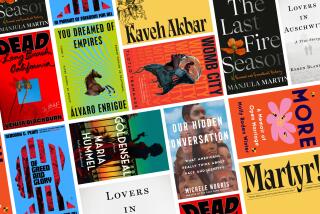Discoveries
ON BULLFIGHTING
By A.L. Kennedy
Anchor Books: 192 pp., $11
Blasphemy is A.L. Kennedy’s specialty. “The Hemingway bravado did nothing for me: the menopausal barroom stories, the foreigner trying too hard to be part of Spain.” In her study of the corrida (the bullfight), Spain must come to Kennedy. Sure, she goes there, whining all the way about the bourgeois tourists, about her aching back, about the heat, but first she must describe her attempted suicide, her lover who left her, her failing career as a writer. A different kind of bravado is required in a writer’s life, she wants to tell us. Different, but the same. Life-denying, lonely, painful. Not bloody, but sometimes, as with Federico Garcia Lorca, whom she reveres, physically dangerous and a cause of death.
Kennedy writes close to the bone; her writing melts into her subject matter even as she tries to stand between them. Her emoting over Garcia Lorca and over the toreros is as flamboyant and clownish and bizarre as the bullfight itself. Her fascination with every detail, from tracing bull bloodlines to studying the metal used to make the picadors’ lances , makes her the perfect observer. The corrida is not art, she argues, and it’s not sport: It’s a religious ritual. She idolizes the toreros. Watching Julian Lopez, “El Juli,” 17 years old, the “Mozart of Torero,” she notices every grimace, every flicker of pride on his face. She analyzes the bull’s casta, or fighting spirit; looks for duende, or what Garcia Lorca called a contact with a “higher source,” ’a painful inspiration.” The book is suffused with pain: Kennedy’s slipped disk, Garcia Lorca’s bravado, the bulls, the toreros. Kennedy must have her own duende, for I have never, in all my days, seen a writer succeed like this in spite of herself.
*
SEABISCUIT An American Legend
By Laura Hillenbrand
Random House: 400 pp., $24.95
‘Seabiscuit” is the story of a self-made magnate, a self-made jockey, a cowboy trainer, a crooked-legged horse and their rise to the kind of American fame which was possible only against the backdrop of the Depression.It is also the story of an American myth-the myth of the underdog, in both human and animal form. Charles Howard, who made his fortune selling the first Buicks in San Francisco, lost his son in a car accident and started hanging around a Tijuana track, where Tom Smith, a man of few words, was a trainer. Something in Seabiscuit, the undersized descendant of Man O’ War, appealed to Smith, who encouraged Howard to buy the horse. Red Pollard, a teenage runaway from Edmonton, Canada, found himself in Tijuana in 1937. He was the jockey who would race Seabiscuit across the country, from Santa Anita to Maryland. One injury after another postponed the race the public longed for: Seabiscuit against War Admiral, the son of Man O’ War, a race that finally took place in 1938 in Maryland. Seabiscuit won. The book is oddly gripping, perhaps because it is such an American tale, but it is exhausting. I am reminded of a local Pulitzer prize-winning biographer who keeps a Post-it on his computer screen that says, “So What?” Every fact is not necessary, no matter how painstaking it was to unearth. Laura Hillenbrand’s account would be more elegant with a few omissions.
*
A PRIMATE’S MEMOIR
By Robert M. Sapolsky
Scribner: 304 pp., $25
Robert M. Sapolsky, a professor of neurology and biology at Stanford University, has spent pieces of the last 20 years studying primates in East Africa. “A Primate’s Memoir” is his wacky account of life among the baboons, the bureaucrats and the Masai. Sapolsky loves Africa, no matter what. He has a huge appetite for life, fed by his Brooklyn humor, a death-is-just-around-the-corner kind of irony. He writes exactly as if he’s telling stories around a fire in the bush. And drinking. And gesturing (he gestures with abrupt sentences, commas, whatever he can get his hands on).
“I am the angel of death,” he writes of the darting he had to perfect to get the blood samples to study the effects of stress on baboon health. He makes fun of himself, at home in his “tribe of eggheads” or in Africa with his troop of baboons. “When I went off to Africa for the first time to join the baboons, I had an array of skills and experiences that would prepare me for anything I’d encounter in that new world. I knew a great deal about the subway system in New York City.”
But nothing prepared Sapolsky for the sorrow, after so many years, of losing many of the baboons he had studied to tuberculosis. He still studies baboons but does not feel quite the same way about his new troop. “Once I was 20,” he writes, “and I had an infinity of love to expend on a troop of baboons.”
More to Read
Sign up for our Book Club newsletter
Get the latest news, events and more from the Los Angeles Times Book Club, and help us get L.A. reading and talking.
You may occasionally receive promotional content from the Los Angeles Times.








